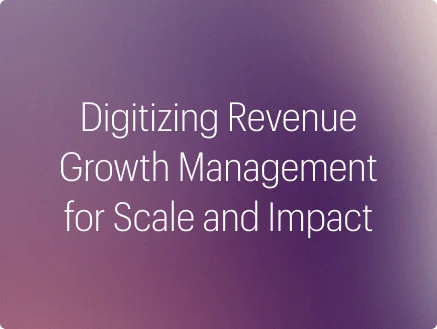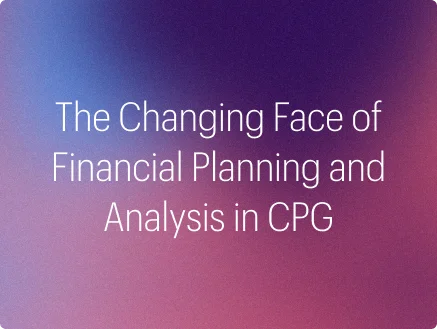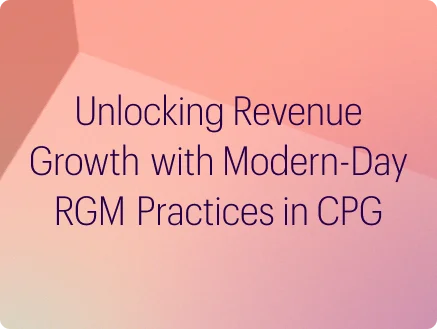The consumer packaged goods (CPG) industry is one of the most hypercompetitive and challenging business domains. It has a large number of brands, retailers, and various other players, all vying for a major chunk of the market share. This dynamic industry has faced numerous disruptions in the past two years that played a major role in transforming crucial aspects like shopper behavior, channel dynamics, supply chain, and workforce.
After constant disruptions and resultant transformations, the CPG industry is slowly adjusting to the current market dynamics. Most CPG brands have undergone different levels of digital transformations. They are adapting to new shopping habits. But according to industry forecasts, more disruptions are on the way as geopolitical issues and macroeconomic factors cast a cloud of uncertainty over the CPG landscape.
To cope with this uncertain financial period and safeguard their revenue streams, CPG companies should focus on Revenue Growth Management (RGM). In this article, we will look at the principles of modern-day RGM in detail and analyze how an effective RGM transformation will bring value to CPG businesses.
What is Revenue Growth Management?
RGM is an organizational approach for generating revenue by selling the right product or service to the right customer at the right price at the right time. Even though the definition might sound straightforward, implementing it across a company is not easy. Establishing strategies, processes, and management control systems across various departments to enable revenue growth is complicated, especially in these highly uncertain times.
Traditionally, RGM was always considered a reactive tactic. It involved minor tweaks in pricing, inventory, promotions, assortment, and trade investment after considering industry dynamics. However, following the pandemic outbreak, CPG companies realized the importance of anticipating and adapting to disruptive events in advance.
The principles of modern-day RGM are more pre-emptive. It uses AI and analytics to help companies generate vital insights on various facets of the industry and create a streamlined flow of revenue by reviewing, remodeling, or adjusting different strategies on an ongoing basis.
How RGM brings value to CPG businesses
#1 Pricing:
Price is one of the primary factors that drive purchase decisions. Based on a market study conducted in the US, about 72% of consumers [1] are extremely worried about the economic situation. As concerns about inflation keep growing among consumers, CPG companies must take a nuanced approach and design smart pricing strategies.
With an AI-led RGM transformation, CPG companies can analyze various aspects like price sensitivities and elasticities, market volatility, competitor prices, etc., to make informed decisions. By analyzing these factors and generating critical insights, CPG companies can develop a dynamic pricing model and ascertain the optimal price point for selling a product or service.
Here is an instance of how AI is enabling RGM transformation through successful pricing strategies:
An American multinational CPG firm [2] is activating its pricing lever by integrating real-time data and industry expertise. The company invested in analytics technology and launched a proprietary data framework for empowering its retailers with granular insights on intricate factors such as consumer behavior (both in-store and online), value perception and concerns, competitor pricing, purchase frequencies, etc. With this holistic approach, the company is coordinating effectively with retailers to develop a streamlined pricing strategy focusing on consumer retention and expansion while driving significant revenue.
#2 Promotions:
In the CPG domain, promotional strategies play a key role in defining success. But according to an industry report, over 72% of promotional efforts do not produce the intended results, and over 80% of CPG brands fail with on-shelf promotions [3]. While traditional strategies end up not delivering positive returns, the CPG landscape is going through another evolutionary phase after the advent of the direct-to-customer (DTC) model. And coming up with omnichannel promotional strategies is going to be daunting for CPG companies.
RGM transformation is ideal for addressing these issues. By harnessing the power of AI and analytics solutions, RGM can help CPG brands create personalized promotional campaigns with better customer segmentation to generate a positive revenue stream, penetrate new markets, drive topline growth, and entice new customers.
A renowned multinational food company [4] is tackling inflationary pressures by focusing on maximizing its promotional budget. Aided by AI technology, the company is conducting campaign effectiveness studies in a faster and more efficient manner while incorporating multiple complex parameters like location data, consumer attributes, and much more. By doing so, the company is generating accurate insights that help enhance its promotional efforts. Likewise, a Swiss food and beverage processing conglomerate [5] is using intelligent data models and ML algorithms to improve its promotional activities. The company is empowering its sales team with comprehensive market insights to develop value-generating promotional campaigns by responding to evolving consumer needs and preferences almost instantaneously.
#3 Trade investment:
Trade investment is a crucial growth driver for the CPG industry. It features marketing strategies aimed at vendors (wholesalers or retailers) instead of final consumers to help CPG companies boost their market share, enhance brand awareness, and gain a healthy profit margin. But most companies do not get their trade investment initiatives right and end up losing a significant amount of revenue.
Based on an industry report, companies have historically faced a slippage rate [6] of 4% to 5% when it comes to trade investment, which impacts the ROI. But with an AI-driven RGM transformation, these companies can bypass the lingering trade investment hurdle. With the help of analytics solutions, CPG manufacturers can efficiently plan their promotional investments (consumer and trade), create distinct KPIs for vendors, and much more.
#4 Assortment and distribution:
Assortment optimization and distribution planning are two key factors that drive product sales and boost customer experience in the CPG industry. A CPG company might have a large assortment, but for the retailer who allocates shelf space, only the right products matter. Therefore, designing the right merchandising mix and distributing it to retailers and consumers is a big challenge for CPG companies.
RGM transformation with the help of AI and data-driven analytics solutions can aid SKU (stock keeping units) rationalization to identify and eliminate underperforming products from the portfolio. By fine-tuning the assortment, CPG companies can distribute the appropriate product mix to the customers on the right shelves and in the right markets, increasing revenue margins, building brand loyalty, and creating a positive relationship with the retailer.
A British multinational CPG company [7] uses a data-driven tool to delist underperforming SKUs and optimize its brand portfolio. The tool can conduct a detailed assessment of the company’s product portfolio using advanced analytics and deliver precise delisting recommendations by comparing different factors associated with all stakeholders (retailers, consumers, and the company). As a result of it, the company can enhance its on-shelf presence, both in the physical and digital channels. Similarly, a Dutch multinational brewing company [8] uses data at every stage of its supply chain to eliminate inefficiencies. By combining data and AI, the company is streamlining route planning, analyzing the best sequence of customer visits, creating ideal assortment proposals, and much more.
Summary
The time is apt for CPG companies to embrace AI and analytics powered RGM strategies. But before applying the principles of RGM, it is important to understand the interconnectedness or the dynamics between its four key levers: price, promotion, demand, and assortment. For an organization, activating any one of these levers will require a certain level of analytical maturity. And on top of that, focusing on one lever could automatically impact other aspects of an organization. Therefore, before executing a full-fledged RGM strategy, one must know their organization’s strengths and where the opportunity for growth lies.
Check out our other articles on the CPG industry, where we talk about how CPG companies can weather the economic storm and the importance of omnichannel strategies.
Bibliography
1. “Consumer Inflation Sentiment – December 2022.” Pymnts.com, December 5, 2022. https://www.pymnts.com/study/consumer-inflation-sentiment-finance-recession-economy/.
2. Johnston, Lisa. “Q&A: PepsiCo’s Chad Matthews on Contextualizing Pricing with Analytics.” Consumer Goods Technology, October 20, 2022. https://consumergoods.com/qa-pepsicos-chad-matthews-contextualizing-pricing-analytics.
3. “Crisp and Promomash Announce Breakthrough Integration for Trade Spend Performance and Analysis.” Business Wire, October 25, 2022. https://www.businesswire.com/news/home/20221025005323/en/Crisp-and-Promomash-Announce-Breakthrough-Integration-for-Trade-Spend-Performance-and-Analysis.
4. Johnston, Lisa. “3 Ways Kraft Heinz Sees Its Historic Tech Investment Paying Off.” Consumer Goods Technology, September 19, 2022. https://consumergoods.com/3-ways-kraft-heinz-sees-its-historic-tech-investment-paying.
5. “Accelerating Data-Driven Digitalization: Nestlé Annual Report.” Nestlé Global. Accessed March 16, 2023. https://www.nestle.com/investors/annual-report/digitalization.
6. PYMNTS. “Real-Time Data Maximizes CPG Firms’ Promotion Spend, and Bottom Lines .” Pymnts.com, April 28, 2022. https://www.pymnts.com/news/retail/2022/real-time-data-maximizes-cpg-firms-promotion-spend-and-bottom-lines/.
7. Unilever PLC. “Using AI to Optimise Our Portfolio.” Unilever, April 8, 2022. https://www.unilever.com/news/news-search/2022/using-ai-to-optimise-our-portfolio-and-fuel-growth/.
8. Brans, Pat. “Digital Transformation Is Brewing at Heineken: Computer Weekly.” ComputerWeekly.com, October 3, 2022. https://www.computerweekly.com/news/252525617/Digital-transformation-is-brewing-at-Heineken.



